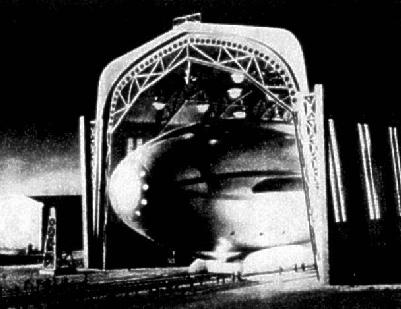
Home - Search - Browse - Alphabetic Index: 0- 1- 2- 3- 4- 5- 6- 7- 8- 9
A- B- C- D- E- F- G- H- I- J- K- L- M- N- O- P- Q- R- S- T- U- V- W- X- Y- Z
The Space Explorers

Rollout of W-1
Weltraumschiff 1 Startet!
In the summer of 1939, at the Bavaria studios, work started on the film 'Zwischenfall im Weltraum' (Incident in Space), under the direction of R A Stemmle. At the same time the Ufa studios (Babelsberg) began the shooting of 'Weltraumschiff 18' (Spaceship 18), director Eduard von Borsody. Both projects were cancelled due to the outbreak of the war, but material already shot - probably from 'Zwischenfall', but maybe from both films - was used for the production of a short film 'Weltraumschiff 1 startet' (Spaceship 1 Launches), with the nominal director being Anton Kutter.
The resulting film was a special effects landmark but only 20 minutes long. It showed the roll-out of the spaceship from the immense Zeppelin Works hangars in Friedrichshafen. Television crews and thousands of spectators are present for the event. Following a short press conference a catapult launch is made from track laid along the north shore of Lake Constance. The spaceship approaches the Moon, loops around it (these scenes include the best special effects in the film) and returns to Earth.
The flight was expected to take place in 1963 or 1964. Although the film has been called 'Nazi Science Fiction', there were no traces of overt Nazi ideology. The only indication the events may be occurring in the Thousand-Year Reich is the mention of a mountain observatory in a German colony in Africa (presupposing Germany regaining the African colonies that were taken from it at the end of World War I).
A director of 'mountain movies' before the war, Anton Kutter was responsible in wartime for production of a number of Kulturfilme (short documentaries which were screened just before the main feature). It seems that 'Weltraumschiff 1 startet' was billed as Kulturfilm, too, and shown accordingly throughout the Third Reich (in France it was released in 1943 as 'Voyage dans le Monde'). An overtly Nazi film directed by Kutter at this time was Germanen gegen Pharaonen 'The Germans versus the Pharaohs', which popularized Nazi theories about the early wanderings of the Aryan peoples. In the 1950s Kutter resumed his directing career, his most notable achievement being 'Das Lied von Kaprun' (Song of Kaprun), about the building of a huge dam in Austria.
There the matter seemed to rest until 1957, when the footage from 'Weltraumschiff 1 startet' was reused by Fred Ladd, an animator, director and co-producer at a small New York company called Radio & Television Packagers. The company was run by William Cayton (later Mike Tyson's boxing manager). Seeking to cash in on the post-Sputnik space boom, Cayton and Ladd produced The Space Explorers 'in collaboration with the Hayden Planetarium of New York' to teach the youth of America the fundamentals of astronomy. The ten six-minute segments were syndicated to local children's programs across the US and made a powerful impression on a generation of space-crazy youngsters.
The opening credits set the story in 1978, and used the German footage to show the ramp-launch of the 'Polaris' spacecraft. Commander Perry, commander of the first expedition aboard the Polaris I to Mars, has disappeared. His son Jimmy stows away in a shipping crate loaded onto the Polaris II rescue ship. The commander of the Polaris II was Professor Nordheim. Smitty, a female assistant, accompanies him on the voyage. When Jimmy is discovered after the launch of the Polaris II, the stage is set for the remainder of the series. Jimmy is taught a new aspect of astronomy each week, using footage from a Czech film 'Univers'. When the Polaris II lands on the Moon, his father is discovered alive there. It turns out that he was not able to land on Mars, but crashed on the moon on the return journey.
The visuals from the series are what most boomers remember. There were the awesome views of space through the glazed nose of the Polaris-II. There was the expanding lunar disk with the Polaris approaching the rolling terrain. The emotional concluding episode featured the call to Jimmy's sister that they've come home, with both the Polaris II and the repaired Polaris I landing side-by-side.
The series was successful and followed up by a second tranche of episodes, The New Adventures of the Space Explorers. These taught young viewers the fundamentals of relativity (!) The projector of the Hayden Planetarium appeared both as a space probe and as the backdrop for the closing credits.
Many thanks to Ralf Buelow, Berlin, and Bill Higgins, USA, for running down the details of a vague childhood memory. Copies of 'Weltraumschiff startet' are held at the Berlin Filmarchiv and the Friedrichshafen Zeppelinmuseum. No one seems to have been able to locate a copy of 'Adventures of the Space Explorers' yet!
Back to top of page
Home - Search - Browse - Alphabetic Index: 0- 1- 2- 3- 4- 5- 6- 7- 8- 9
A- B- C- D- E- F- G- H- I- J- K- L- M- N- O- P- Q- R- S- T- U- V- W- X- Y- Z
© 1997-2019 Mark Wade - Contact
© / Conditions for Use